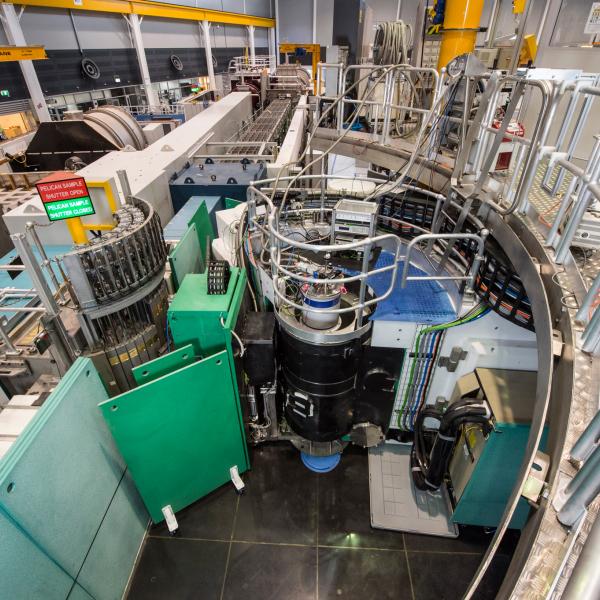

Published on the 10th July 2020 by ANSTO Staff
Key Points
-
Research provides evidence of a highly unusual quantum state, a quantum spin liquid, that could be used in the development of spintronic devices, quantum computers and other transformative quantum technologies
-
A large international team led by the Tokyo University of Science synthesised a material which did not exhibit any spin ordering or freezing in experiments at a range of low temperatures
-
Spin excitations were observed in spectra from the Pelican time-of-flight spectrometer at 50mK
ANSTO has provided supporting experimental evidence of a highly unusual quantum state, a quantum spin liquid (QSL), in a two-dimensional material as reported by an international collaboration led by Tokyo University of Science in Nature Communications.
Materials with quantum spin liquid states could be used in the development of spintronic devices, quantum computers and other transformative quantum technologies.
In a quantum spin liquid, an elusive state of matter that is the subject of much investigation worldwide, the electron spins in a magnetic material never align but continue to fluctuate even at the lowest temperatures. This lack of ordered magnetic spin alignment in a solid structure has been described as fluctuating liquid-like state.
Low energy spin excitations, evidence of a QSL, were detected at a range of very low temperatures in experiments at the J-PARC facility in Japan. Importantly, the expected spin ordering or freezing was not detected in the inelastic neutron scattering spectra.
Instruments scientists Dr Richard Mole and Dr Dehong Yu used inelastic neutron scattering, a spectroscopic technique to detect the vibrations of atoms, on the Pelican instrument at ANSTO. Instrument scientist Dr Shinichiro Yano liaised with the group in Japan and also collaborated on the experiments.

Inelastic neutron scattering data of KCu6AlBiO4(SO4)5Cl. Pelican measurements plotted at h. This figure is licensed under a Creative Commons Attribution 4.0 International License to the authors of the paper which appeared in Nature Communications https://doi.org/10.1038/s41467-020-17235-z
“When we analysed the Pelican data at 25K 15 K and 48mK, we could see the same spin excitations and they persisted to the lowest temperature, which is only slightly above absolute zero,” said Mole.
In order to create these low-temperature environments, Gene Davidson from the sample environment team at the Australian Centre for Neutron Scattering optimised a special type of cryostat called a dilution insert on the Pelican instrument.
“Although this sample environment has been used on other instruments, this was the first application on Pelican. It is very important in experiments relating to quantum phenomena,” said Mole.
“The spin excitations which we observed in the spectra provide one of the signatures for a quantum spin liquid state, a novel phase of matter,” explained Yu.
“A quantum spin liquid state possesses extensive many-body entanglement, a kind of correlation, or a link between all the spins. As an analogy, think of a bucket of water with several fishing floats on the surface. If you disturb one float, all the floats will also be disturbed.”
“However, for a real piece of solid material at spin liquid state, all atoms in the material are completely frozen except the spin of the electrons.”
The investigators reported the spin liquid as ‘gapless’, an unusual characteristic that refers to a lack of discrete energy changes in the local environment.
The crystal structure of the new antiferromagnetic compound, KCu6AlBiO4(SO4)5Cl, that was synthesised by the group in Japan, has a geometry described as a square kagome lattice.
Unlike the regular kagome lattice, the square kagome lattice is comprised of two sub-lattices that are not equivalent. Each square kagome unit has three types of nearest neighbour magnetic interactions from the spins of copper atoms in the structure.
Other experimental studies, which included magnetic susceptibility, magnetisation, heat capacity, and muon spin relation measurements, also supported the presence of a quantum spin liquid in the material.
The publication authors, led by Masayoshi Fujihala, reported that the quantum spin liquid behaviour could not be explained theoretically by the frustrated Heisenberg model with nearest neighbour exchange interactions.
Participating institutions in Japan and Taiwan included various groups at Tokyo University of Science, the J-PARC Centre, the National Synchrotron Radiation Research Centre, the RIKEN Centre for Computational Science, University of Toyama, and the High Energy Accelerator Research Organisation (KEK).
DOI: https://doi.org/10.1038/s41467-020-17235-z
Read more on the Tokyo University of Science website


